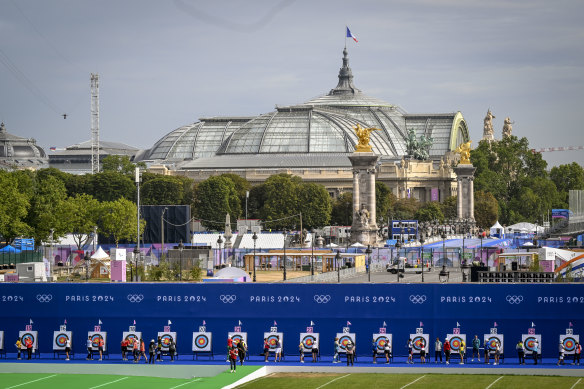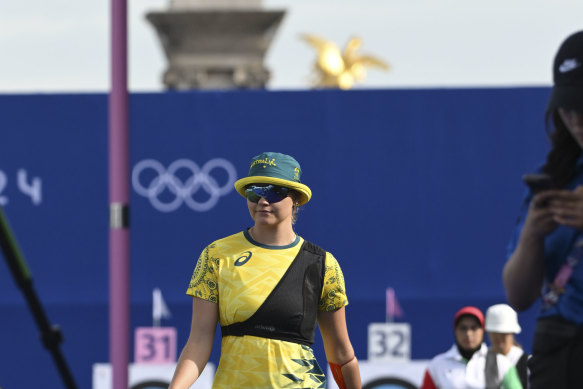Draw your quivers: Archers aim for gold in the grandest of venues
As the best archers in the world took their place, drew their quivers, found their line of sight, and quietly let fly, it was all too easy to admire their deadly precision. Such unflinching control. Such unwavering accuracy.
One wonders what military minds might see in such cool focus. What would it stir in the great Gallic general Napoleon Bonaparte, for instance?

Olympic archery is being staged in one of the standout venues for Paris 2024 – the historic Hotel des Invalides, near the Eiffel Tower and the Grand Palais (pictured in background).Credit: Eddie Jim
I only ask because the historic figure known as “The Little Corporal” – the former leader of the French Republic – is interred just back there, behind the bullseyes, in a tomb made of red quartzite atop a plinth of green marble, inside one of the grandest venues selected for these Olympics: Les Hotels des Invalides.
When you think of historic Olympic stadia, your mind’s eye might drift to the Panathenaic Stadium in Athens – a horseshoe arena built entirely of marble in the 4th century BC – or perhaps to something more modern, like the Bird’s Nest from Beijing in 2008. But at this “light touch” games in Paris, grandiosity is delivered with an effortless haughty shrug, by repurposing the gravitas of the city itself. Such is the case with des Invalides.
The complex – which today houses a temporary stadium built to hold 7400 spectators when the medals are on the line next week – sits in the beating heart of the 7th arrondissement, on the Left Bank in central Paris, alongside the Eiffel Tower and the Musee D’Orsay. It’s opposite the Pont Alexandre III Bridge – an ornate link to the Grand Palais on the other side of the Seine.
Built in 1674 by the Sun King, Louis XIV, the compound is surrounded by prime real estate – the traditional home to French nobility and the highest aristocracy. But des Invalides was initially conceived as a military hospital and retirement home for suffering war veterans.
Oh so many poor soldiers must have languished and anguished and perished here. Do you believe in des fantomes? If ghosts were real, we could ask them what they made of the weaponry on show in the ranking round for Olympic archery on Thursday.
Were they impressed by the 64 men and 64 women in competition? Would they be good enough to serve in the Napoleonic Wars?
Bonaparte would likely scoff at the idea. His officers were armed with pistols and sabres, after all, and his infantry with muskets and bayonets. Bows and arrows? The very idea is preposterous.
“Arc et des fleches?” he would ask. “Non. Absolument pas!”
But the Corsican Ogre would be dead wrong. The musket was cumbersome, and woefully inaccurate too. Over the Olympic distance of 70 metres, measured out on the manicured greenery between these historic structures, a modern archer armed with a $4000 carbon fibre recurve bow with aluminium risers and hickory limbs would silently destroy the front line of the Armee Imperiale.
And what of Australia’s best bowmen? Our Artemis and Apollo – or Katniss Everdeen and Hawkeye, if you prefer – are Olympic debutants Laura Paeglis and Peter Boukouvalas.

Laura Paeglis, 22, got into archery when she was 10, after watching Princess Merida in the animated movie Brave. Now she’s an Olympian.Credit: Eddie Jim
Paeglis, 22, first picked up a bow as a 10-year-old, after watching Princess Merida in the animated film Brave. The backyard of her home in the Melbourne suburb of Doreen is big enough that she has her own competition length range, meaning she can loose 300-odd arrows a day, which she does.
Boukouvalas, 25, meanwhile, is a university student, SES volunteer and Sydney Trains customer service attendant at St Peter’s Station. He’s of Greek heritage, and was inspired while watching the Athens Olympics in 2004, when Australia last won an individual archery medal.
They’re ranked 60 and 68 in the world, respectively, so they’ll have their work cut out for them in competition, once seedings are settled. But don’t rule them out. At this level, the average archer is a consistently lethal threat.
During a three-hour session under the Parisian sky, each will fire 72 arrows at a target around 1.2 metres in diameter. But the yellow bullseye or “10 ring” at its centre is about the size of a grapefruit, and they’ll nail it around 68 times.
The very best – like current world number ones Casey Kaufhold, of the USA, and Marcus D’Almeida, of Brazil – will do even better. At least they’ll need to if they want to win gold.
The reminder will be right there, too, writ large in the streetscape. For beyond the southern end of the competition field sits the public face of des Invalides – a glorious baroque dome, capped by a glistening lanternon, all gilded in glowing gold leaf, catching the summer sun. What a target.